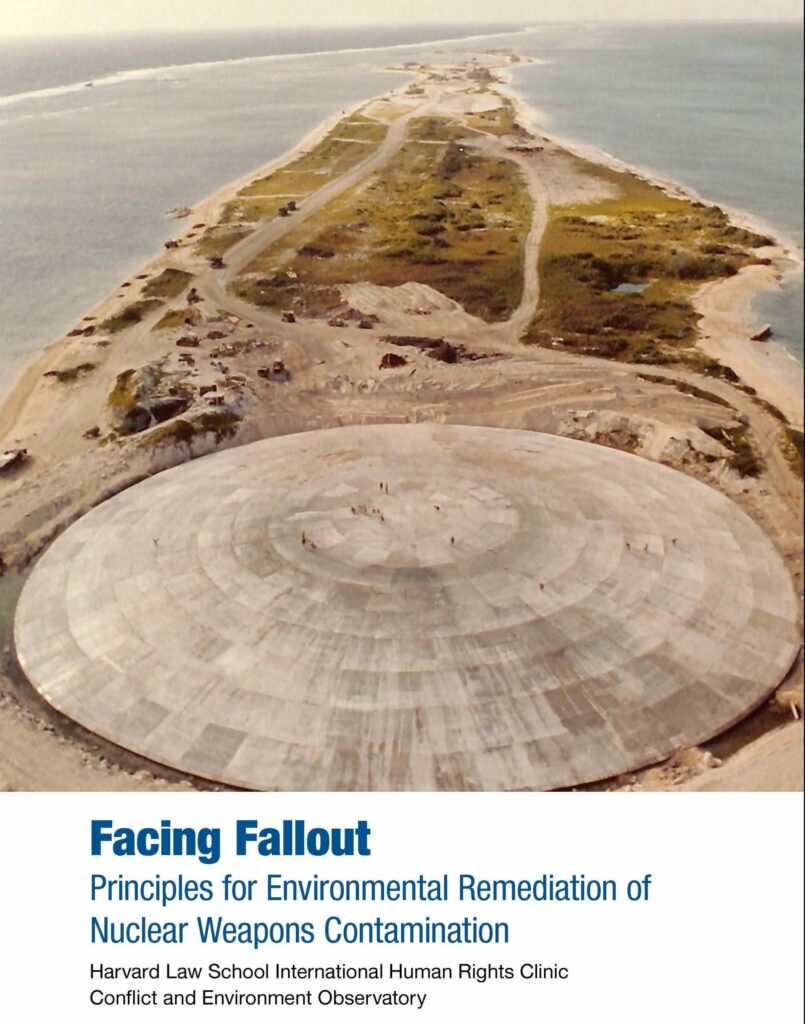When the First Meeting of States Parties (1MSP) to the Treaty on the Prohibition of Nuclear Weapons (TPNW) convenes in Vienna from June 21-23, much of the discussion will center on how to implement the treaty’s positive obligations to remediate the contaminated environment and assist victims.
These provisions are critical because nuclear weapons wreak havoc on the environment and the people who live in it. Radioactive contamination from the weapons’ use and testing devastates ecosystems; causes death, disease, and psychological trauma; displaces entire communities; destroys cultures; and more.
To respond to this harm and inform the 1MSP’s debate, the Harvard Law School International Human Rights Clinic (IHRC) and the Conflict and Environment Observatory (CEOBS) have released a new report entitled Facing Fallout: Principles for Environmental Remediation of Nuclear Weapons Contamination. The report identifies 19 principles for implementing remediation measures and includes an in-depth commentary with explanation and precedent for each.
Facing Fallout complements a 2020 report by the same authors entitled Confronting Conflict Pollution: Principles for Assisting Victims of Toxic Remnants of War. Victim assistance directly addresses the harm nuclear weapons cause to humans, while environmental remediation responds to its major underlying cause, i.e., radioactive contamination. Collectively, the reports set up a framework for a long-term response to th
e consequences of nuclear weapons.
A new IHRC fact sheet, also released today, summarizes the environmental
remediation and victim assistance principles and lays out measures for initiating implementation to which TPNW states parties should commit at the 1MSP. In particular, the 1MSP should agree to: assess needs and state capacity, create a national infrastructure for environmental remediation and victim assistance, establish an informal intersessional working group, promote inclusivity, and uphold guiding principles of implementation. The fact sheet’s recommendations are similar to those put forth in a working paper by 1MSP co-facilitators Kazakhstan and Kiribati.
IHRC and CEOBS based the principles in Facing Fallout on humanitarian disarmament law, international environmental law, international human rights law, and related policies. Where appropriate, they adapted these models to the distinctive characteristics of nuclear weapons.
The principles are especially relevant for TPNW states parties, but they are also applicable to any state that seeks to remediate nuclear weapons contamination in its territory. They are summarized below according to their six categories:
Purpose and Character
Environmental remediation should address existing harm and unacceptable risks of future harm to the environment and affected communities caused by contamination from the use and testing of nuclear weapons. States should follow the precautionary principle and an iterative approach, adopt international standards and best practices, and use best available technologies.
Definition of Harm
The harm caused by nuclear weapons contamination should be understood broadly to encompass, inter alia, environmental degradation; loss of biodiversity; physical and psychological injuries and death; social marginalization; economic loss; loss of access to natural resources; obstacles to participation in cultural life; displacement of local communities; and substantial impairment of the realization of the human rights.
Framework of Shared Responsibility
Affected states should bear primary responsibility for environmental remediation of territory under their jurisdiction or control, while other states should provide technical, material, and financial assistance to help affected states meet their responsibilities. States and non-state actors should exchange scientific and technical information and promote capacity building.
Steps of Environmental Remediation
Affected states should begin by creating a national plan and assessing, surveying, and recording the problem, although plans and assessments may need to be updated over time. Affected states should also conduct an optimization analysis in which they evaluate different options and implement the one that produces the greatest benefit to affected communities and the environment. The analysis should take into account environmental, human health, social, cultural, and economic considerations as well as the preferences of affected communities and other stakeholders.
Affected states should ensure risk education is available. They should break, disrupt, or remove pathways by which people are exposed to contamination, such as through marking and fencing and controlling food and water sources. If robust remediation is necessary and appropriate, they should address the contamination itself through containment and other treatment measures. Taking care during handling, transport, and removal of waste as well as long-term site management is also critical.
Handling of Information
Affected states should collect and disseminate information about affected sites and communities and remediation measures, and preserve it for the conceivable radiological life of the contaminated waste.
Guiding Principles
Affected states should meaningfully consult with and actively involve affected communities, their representative organizations, nongovernmental organizations, and other stakeholders at all stages of the remediation process. They should adhere to the principle of non-discrimination and ensure transparency of the process.
*****
TPNW states parties should take advantage of next week’s 1MSP to make concrete commitments to begin the process of operationalizing the treaty’s positive obligations. But in the intersessional period and beyond, they should start looking to the future and develop a long-term framework for environmental remediation and victim assistance. The IHRC-CEOBS principles and commentaries provide in-depth and well-grounded guidance for that endeavor.
Bonnie Docherty, associate director of armed conflict and civilian protection IHRC was co-author and editor of Facing Fallout. A number of IHRC students contributed significantly to the conceptualization, research, and writing of the report: Naima Drecker-Waxman, Andie Forsee, Gillian Hannahs, Amy Hayes, David Hogan, Lavran Johnson, Jillian Quigley, Erin Shortell, Dane Underwood, Theo Wilson, and Jack Jaehyuk You. CEOBS provided guidance and review of the report.
